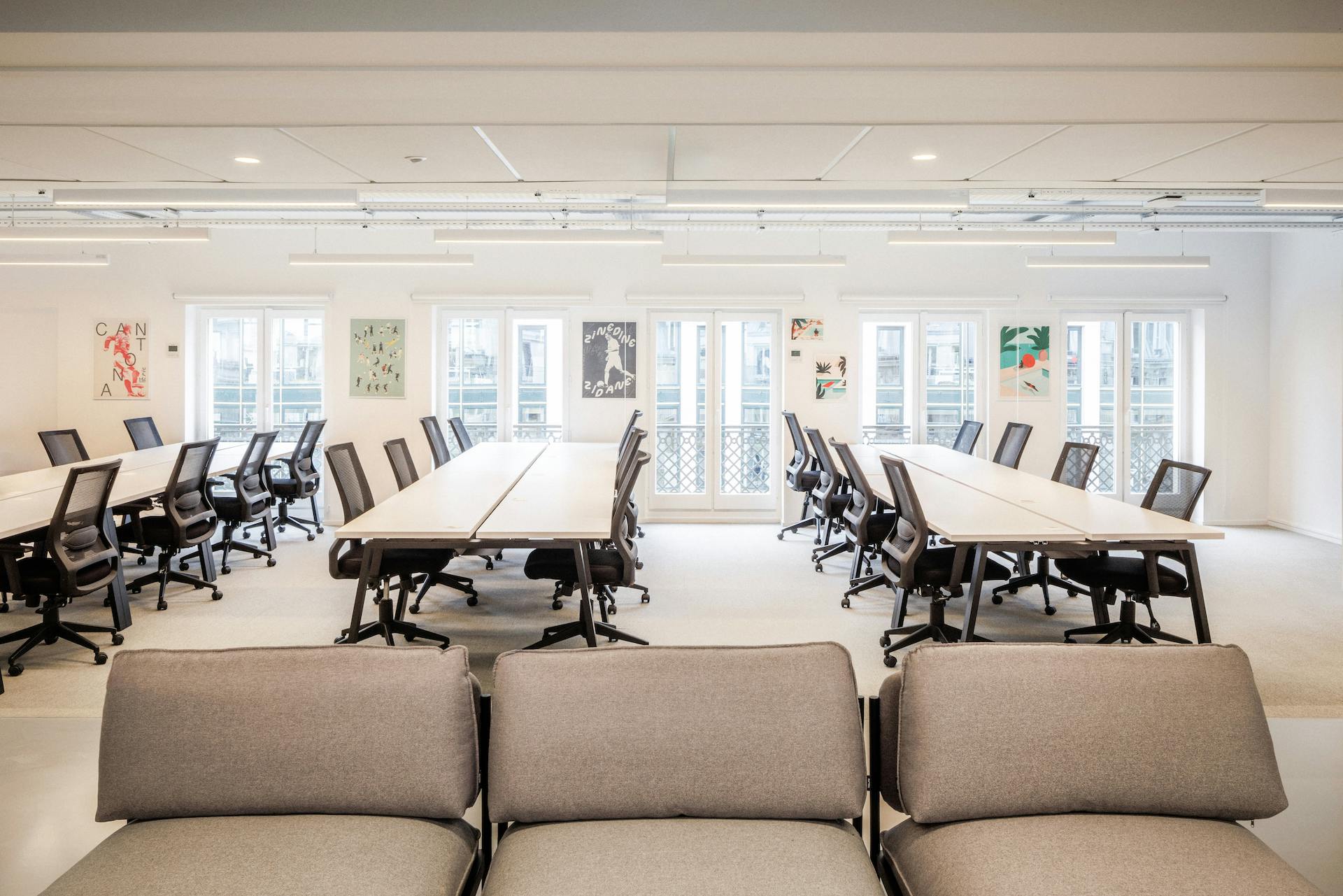

Organizing successful business meetings in 2024
2024 sounds like a year when business efficiency and productivity are more crucial than ever. In this ever-changing context, the way we organize our business meetings is of paramount importance... The success of a meeting is measured not only by the way it is held, but also by its meticulous preparation, dynamic management and ability to catalyze innovation and collaboration.
At a time when new technologies are emerging and professional practices are reinventing themselves, this article explores the strategies and tricks essential to orchestrating fruitful and effective work meetings throughout 2024.
What is a business meeting ?
A business meeting is a formal or informal gathering of several people in a professional setting. Its purpose: to discuss, plan, decide or solve problems linked to a project, a strategy or operational issues within a company. Also known as department meetings, internal meetings or team meetings, these meetings encourage the exchange of ideas, collaboration and coordination between participants.
Objectives and purpose of a business meeting
Work meetings aim to achieve several objectives:
- Foster internal communication,
- Share relevant information,
- Make collective decisions,
- Solve problems,
- Encourage creativity and innovation,
- Align teams on common objectives,
- Evaluate progress.
They also reinforce employee commitment, clarify roles and responsibilities, and ensure better coordination of actions.
Different types of work meetings
There are various types of work meeting, each with its own specific features and objectives. Among the most common are strategic planning meetings, project follow-up meetings, problem-solving meetings, brainstorming meetings to generate new ideas, training or presentation meetings, and performance appraisal meetings.
Each type of meeting requires specific preparation, an adapted structure and particular communication methods to effectively achieve its objectives and ensure the active participation of members.
Keys to successful meeting preparation
Strategic participant selection
Careful selection of participants is crucial to the success of a business meeting. Inviting those whose presence and contributions are indispensable is essential to achieving the set objectives. Too large a group can dilute exchanges, while too small a group can miss out on important points of view.
Here are a few tips to help you select the right participants for your meeting:
- Define the objectives of the meeting: Making clear the aims and topics to be addressed helps identify the people whose contribution is essential to achieving these objectives.
- Evaluate the roles and expertise required: Identify the skills, knowledge and experience required to deal with the items on the agenda.
- Limit the number of participants: Opt for a restricted group including only those individuals whose presence and contributions are directly relevant to the topics to be addressed.
- Adequate representation: Ensure a diversity of perspectives by including representatives from different departments for a holistic view of the subject.
- Regular re-evaluation: After the meeting, assess whether the presence of each participant was really necessary and whether others should be included or withdrawn for future meetings.
Effective meeting planning
Careful planning is essential to ensure a successful meeting. For example, defining concrete objectives such as 'Define next steps for project X' or 'Evaluate last quarter's performance' helps direct the discussion towards specific outcomes. Drawing up a detailed agenda and sharing it with participants a few days before the meeting gives them the opportunity to prepare adequately. We won't go into more detail on this topic here, as we've dedicated a full article to it. You can read it here!
Setting a time limit for the meeting, e.g. 60 minutes to discuss three main topics, ensures efficient time management. Allocating specific time slots to each item on the agenda, for example, 20 minutes for discussion of the budget and 15 minutes for proposals for new projects, helps avoid lingering on one subject to the detriment of others.
Choosing the ideal venue for a meeting
The chosen venue has an impact on the atmosphere and effectiveness of the meeting. A peaceful space, equipped with essential technological tools (such as screens and a reliable Internet connection), as well as an appropriate level of comfort, promotes concentration and encourages the active participation of participants. The layout of the room according to the type of meeting (panel discussion, presentation, etc.) is also one of the aspects to consider.
Preparing documents and materials
Gathering and distributing key documents, graphics, presentations or reports needed before the meeting allow participants to refer to them and contribute in an informed way. Visual and interactive aids, such as charts, diagrams or demonstrations, can enhance participants' understanding and engagement during the meeting.
How to run an effective business meeting
How to introduce the meeting
Start by giving a warm welcome to participants. Next, briefly review the agenda and planned objectives for the meeting. This helps everyone remember the key points to be addressed, steering the discussion in the right direction from the outset.
Creating a climate conducive to exchange also requires a succinct presentation of the rules of participation. This can include simple guidelines such as respecting speaking time, actively listening to each other's ideas and being willing to accept divergent opinions in a constructive spirit.
Finally, actively encouraging the contribution of all participants is also essential. For example, by clarifying expectations about their role within the meeting, you stimulate more dynamic and involved participation. You could invite everyone to share their ideas, experiences or points of view right from the start, creating an open and inclusive environment.
Guarantee the smooth running of the meeting
Make sure you stick to the set agenda, giving everyone a chance to speak and encouraging balanced discussion. Stick to the timing for each topic, and make sure you keep the discussions on track. If necessary, bring the conversation back to the main objective to avoid excessive deviations.
In the event of disagreement, encourage the search for solutions by encouraging constructive debate and exploring different perspectives. This can be done by asking for concrete examples to back up arguments, or by proposing alternatives for resolving differences.
Don't forget to ensure that all decisions taken are noted for inclusion in the included in the meeting minutes that will be sent out afterwards.
Effective conclusion to the meeting
Summarize the key points discussed, recall the actions to be taken and everyone's responsibilities. Conclude on a positive note, thanking participants for their contribution and setting out next steps, to ensure continuity of the efforts undertaken at the meeting.
Tools and methods for a successful meeting
To guarantee the success of a meeting, the appropriate use of tools and methods proves essential. Here are a few to help you optimize your business meetings:
| Type | Tools | Advantages |
|---|---|---|
| Video conferencing platform | Zoom, Microsoft Teams or Google Meet | Facilitates remote meetings, enables real-time interaction between remote participants and offers features such as screen sharing, waiting rooms and chat options for smooth communication. |
| Online collaboration tool | Trello, Asana or Slack | Facilitates collaboration and task management, lets you set goals, assign tasks, and track progress. |
| Visual support | Interactive whiteboards, PowerPoint presentations or Excel spreadsheets | Help to illustrate and clarify information, reinforce understanding of the topics covered, encourage participant involvement. |
| Brainstorming methods | Traditional brainstorming, Bono's 6 hats method, or mind mapping | Encourages everyone to participate and explore different perspectives. |
| Time management techniques | Timers or methods such as Pomodoro | Helps maintain an efficient pace during the meeting, by segmenting discussion time for each topic to avoid excessive prolongation |
Some tips for successful communication during the business meeting
Here are some of our tips for fostering successful communication:
1. Active listening: Pay close attention to what participants have to say, show interest and ask questions to clarify points raised. This encourages constructive dialogue.
2. Clarity and conciseness: Express yourself clearly and concisely. Use short sentences and avoid complicated jargon so that you can be understood by everyone.
3. Encourage participation: Foster an inclusive environment by encouraging the participation of all members. Solicit input from everyone for a balanced contribution.
4. Managing interruptions: Establish rules to minimize interruptions, such as raising your hand to speak, to maintain the flow of the meeting.
5. Constructive feedback: Provide constructive feedback on proposed ideas, valuing contributions and remaining open to suggestions.
By applying these tips, exchanges during the meeting will flow more smoothly, encouraging effective communication and better sharing of ideas between participants.


Contact Us
We find your Perfect fit!

